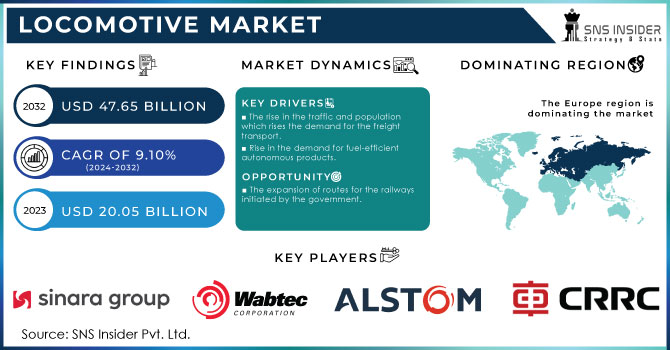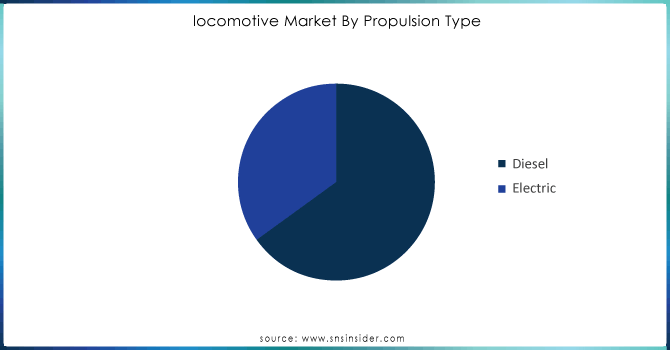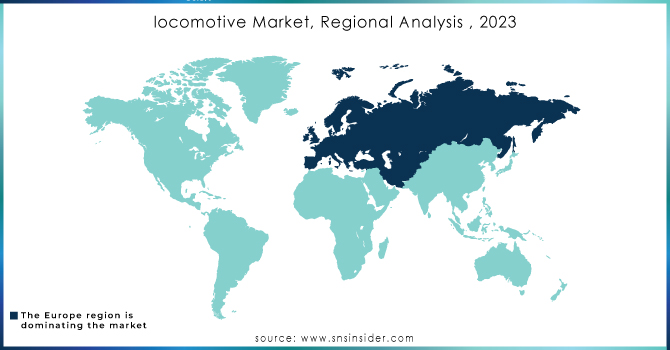Locomotive Market Report Scope and Overview:

Get More Information on locomotive Market - Request Sample Report
The locomotive Market size was valued at USD 20.05 billion in 2023 and is expected to reach at USD 47.65 billion by 2032, and grow at a CAGR of 9.10% over the forecast period of 2024-2032.
The locomotive market is used for freight routes where there is an advanced railway network. There has been continuing innovation for locomotives in terms of operating systems and so forth. The main purpose behind using electric locomotives over diesel locomotives is to reduce maintenance costs and pollution. There has been an increase in urbanization, and also an increase in traffic, which is giving a boom to the locomotive market. There has been immense growth in technological advancement in the railway management sector, which contributes to the growth of the locomotive market. These are the basic and most important aspects that will drive the locomotive market during the forecasted period. The rising initiatives taken by every nation around the world, along with efforts by key players regarding net-zero emissions, are contributing to the growth of the locomotive market.
We would also like to mention some of the beneficial facts that highlight why growth is inevitable: carrying more passengers and goods simultaneously. The electric locomotive operates with the help of overhead lines that supply energy or electricity, or through batteries. The current is transferred by means of AC or DC charging methodologies and is stored in batteries, which allow the electric locomotive to cover greater distances. When considering the functionality of the electric locomotive, another benefit is the rise in environmental sustainability programs in almost every nation.
There are restraining and challenging factors for every market, and the locomotive market is no exception. The high initial cost and the infrastructure availability required for the development of electric locomotives are significant restraining factors, particularly in emerging and undeveloped countries. Another major influencing factor is the high cost of diesel locomotives. According to statements from engineers, the costs associated with diesel locomotives can be saved by using battery-powered locomotives instead. In the U.S., more than 50% of the locomotives are diesel-electric. However, the continuous efforts to make them fully electric and autonomous, along with the initiatives taken for the same, can be considered key elements for the future growth of the locomotive market during the forecasted period.
Market Dynamics
Drivers
-
The rise in the traffic and population which rises the demand for the freight transport
-
Rise in the demand for fuel-efficient autonomous products
-
The low switching cost and the benefits associated with the electric locomotive
-
The dual carbon goal or the zero net carbon emission goal of the nations all around the globe
The goal of the net zero carbon emission will drive the market in all the developed and the emerging countries, the initiative taken by the government to increase the budget and to take initiative to support the activities related to the zero-carbon emission explains the driving factor of the Electric locomotive Market, the rise in the budget allocation of the nations for the motive of environmental sustainability will be a key factor, according to the World Bank air pollution is to be considered as the major reason for the illness and premature death and the fact which cannot be denied is that approx.. 95% of the deaths have tend to happen in the developing countries, for electric locomotive use of lithium-ion batteries will be done also the utilization of the green hydrogen in trains can help achieve this goal but the infrastructure regarding the hydrogen fuel cell can create barrier whereas the high production of lithium-ion batteries will impact the electric locomotive market positively in the present scenario.
Opportunities
-
The expansion of routes for the railways initiated by the government
-
Rapid growth in traffic and a growing population all around the globe
The use of the electric locomotives is done on a large scale specially for the transportation of the freights in the developed countries most of the people use locomotives as a mode of transportation, the number is increasing if we compared it with the historical data, the another important data which we would like po mention is the rising traffic in the developed and the undeveloped countries of several regions, rising traffic is caused by the rise in the sale of the personal vehicles as the availability of the vehicles atlow price can be done which is causing rise in the traffic and that can be the precise reason people are more shifting towards the electric locomotive to save the time and low cost charges compared to the personal or different modes of transport and this what the factors are been considered by the key players and the emerging players to innovate new technologies to satisfy the need also keeping the environmental sustainability factor in mind.
Challenges
-
The requirement of the high capital for the development and the production of the electric locomotive as the global disruptions has disturbed the economic conditions of the nations and the effect will be prolonged as it will depend on the approach of the nation’s recovery process.
Market Segmentation
By Propulsion Type:
Diesel locomotives dominated, holding 65% of the market share of all locomotive sales. It is versatile and can be used on any terrain, giving it a very special place in freight transport. However, with growing concerns over the environment and increasing fuel prices, electric locomotives seem to be the trend. These green machines have now drawn a lot of attention to themselves and have covered 35% of the market. Though their investment cost is more expensive, electric locomotives are called for due to their long-term operational savings and sustainable goals. With increased focus on green initiatives by governments and railway operators, the demand for electric locomotives will surge, which might reduce the gap with diesel-powered cousins.

Get Customized Report as per Your Business Requirement - Request For Customized Report
By End Use:
Segmentation of the locomotive market will fall into different end-uses that are eventuated with different dynamics of demand and potential growth. The passenger segment has had a steady rise in the past years due to the driving forces of urban commuting and long-distance need. The reason for this can be attributed to increasing population, rapid urbanization, and a fast-developing taste for railway transportation, motivated by the fact that it is efficient and eco-friendly. Though passenger segments have seen linear growth, freight has had a more roller-coaster trajectory due to factors such as economic fluctuations, trade policies, and infrastructural developments in transportation. Offsetting this by the current trend of sustainability in transportation and growing dependence on rails for bulk cargo movement, there are still open windows for growth in the freight segment.
Regional Analysis
Europe is the region with the highest share in the total market estimation of the locomotive market. The European locomotive market is undergoing a radical transformation process, mainly because of the increasing demand for electric locomotives. Germany, France, and the UK are leading in this, where more than 60% of new locomotives sold in recent years have been electric. This scenario mainly lies in the strict environmental regulations and an increasing care for sustainable transport. Even though diesel locomotives still enjoy a very decent market share, especially in those countries where the development of electrification infrastructure has not been so big, this stronghold is slowly wearing out. Growing hybrid and hydrogen-fuelled locomotive adoption further underlines the region's commitment to reducing carbon emissions and improving air quality.
APAC is expected to be the region with the second highest share to the market estimation of the market because of the countries like China, Indian and Japan the continuous infrastructural development and the rising demand for the freight transportation.The Asia-Pacific region has become the locomotive of the global locomotive market and continues to capture a huge share of global production and consumption. Indeed, countries like India, China, and Japan have driven this growth through their expanding rail networks and resulting modernization programs. For instance, there is a huge increase in demand for locomotives, especially electric and diesel variants, to serve India's ambitious railway expansion plans. While China, for its part, has invested greatly in high-speed rails; thus, it would require very efficient locomotives.

Key Players
The major key players are TMH, CRRC, Wabtec Corporation, Alstom, Siemens Mobility, Sinara, Stadler, Hitachi, Hyundai, Toshiba International Corporation.
Recent developments:
1. CRRC Corporation :The development of the first High -Temperature Superconducting system (HTS) completed its first suspension operation in China, the basic objective of the development is to improves the transportation channels in the mega cities.
2.Alstom SA : The partnership between the Export Development Canada (EDC) and Alstom SA of worth $3.5 Billion for sustainable mobility financing, as we mentioned earlier that every organization is taking initiative to achieve the goal of zero carbon emission this is the facts to support the statements.
3. Siemens Mobility : Siemens mobility has secured order of €3 billion and it is the first largest contract ever, the order is to provide 1200 electric freight locomotives to Indian railways.
4. Stadler Rail AG :The company has increased the contracts for the bi mode locomotives, one of the major contracts include the framework agreement between Sadler and Trenitalia for the supply of 50 bi-mode locomotives.
| Report Attributes | Details |
| Market Size in 2023 | US$ 20.05 Bn |
| Market Size by 2032 | US$ 47.65 Bn |
| CAGR | CAGR of 9.10% From 2024 to 2032 |
| Base Year | 2023 |
| Forecast Period | 2024-2032 |
| Historical Data | 2020-2022 |
| Report Scope & Coverage | Market Size, Segments Analysis, Competitive Landscape, Regional Analysis, DROC & SWOT Analysis, Forecast Outlook |
| Key Segments | • By Propulsion Type(Diesel, Electric) • By Technology (IGBT Module, GTO Thyristor, SiC Module) • By Component (Rectifiers, Inverter, Motor, Others) • By End User(Passenger Transport, Freight Transport) |
| Regional Analysis/Coverage | North America (USA, Canada, Mexico), Europe (Germany, UK, France, Italy, Spain, Netherlands, Rest of Europe), Asia-Pacific (Japan, South Korea, China, India, Australia, Rest of Asia-Pacific), The Middle East & Africa (Israel, UAE, South Africa, Rest of Middle East & Africa), Latin America (Brazil, Argentina, Rest of Latin America) |
| Company Profiles | TMH, CRRC, Wabtec Corporation, Alstom, Siemens Mobility, Sinara, Stadler, Hitachi, Hyundai, Toshiba International Corporation. |
| Key Drivers | • The rise in the traffic and population which rises the demand for the freight transport. • Rise in the demand for fuel-efficient autonomous products. |
| Market Opportunities | • The expansion of routes for the railways initiated by the government. • Rapid growth in traffic and a growing population all around the globe. |

